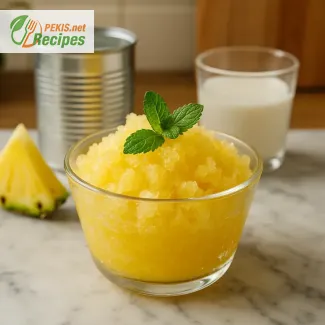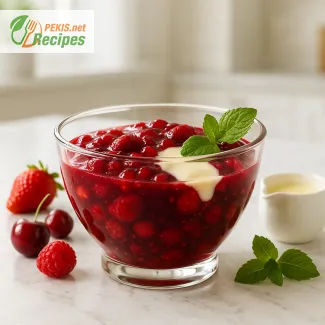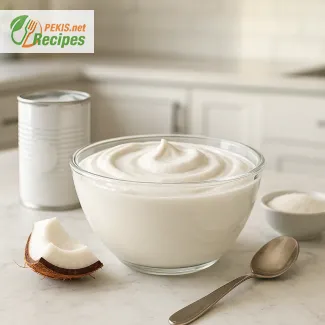
Tropical summer dessert with pineapple and coconut flavor
A cooling treat inspired by Sicilian granita and tropical fruits
When the sun beats down and the air is thick with summer heat, there's nothing more satisfying than a cold, fruity dessert that requires minimal effort and delivers maximum refreshment. Enter the pineapple-coconut granita, a brilliantly simple yet incredibly flavorful frozen treat inspired by the traditional Italian granita, but infused with exotic tropical notes that transport you straight to a beachside paradise. This recipe relies on just two ingredients—juicy pineapple and creamy coconut milk—to create a naturally sweet, dairy-free delight that’s perfect for hot weather, special occasions, or as a light finish to a summer meal.
Granita is known for its crystalline texture, achieved through a process of freezing and scraping the mixture over several hours, resulting in delicate, icy shards that melt effortlessly on the tongue. Unlike sorbet or ice cream, there’s no need for churning or special equipment. The simplicity of this method makes it an excellent choice for home cooks who want a quick, foolproof dessert with a sophisticated presentation. And when paired with pineapple and coconut, it becomes a tropical masterpiece—light, fragrant, and visually stunning in its golden hue.
Why pineapple and coconut are the perfect granita duo
Pineapple, with its vibrant acidity and high water content, is a natural base for granita. Its bright, tangy flavor adds a refreshing punch that balances beautifully with the richness of coconut milk, which brings a creamy texture and subtle sweetness. When combined, the result is a flavor profile that is both exotic and well-rounded, pleasing to adults and children alike.
This duo also happens to be a popular combination in global cuisine—from Caribbean piña coladas to Southeast Asian curries—making it instantly familiar and appealing. The use of unsweetened coconut milk allows the pineapple’s natural sugars to shine, while still delivering a smooth, indulgent mouthfeel that elevates the ice crystals into something almost luxurious.
The texture difference: granita vs. sorbet or ice cream
Granita is often misunderstood as simply a lazy sorbet, but its signature granular texture is what makes it unique. While sorbet is smooth and churned, granita is coarse and icy, giving each spoonful a satisfying crunch followed by a rapid melt. It offers a more dynamic and tactile experience than ice cream, without any dairy or eggs. This textural quality not only enhances the eating experience but also makes granita ideal for layering with fresh fruit, herbs like mint or basil, or even a dash of rum for an adult twist.
The combination of pineapple and coconut enhances this contrast even more: the juicy shards from the fruit and the creamy silkiness from the coconut provide a rich yet refreshing feel that stands apart from other frozen desserts. The texture is light and airy, yet deeply flavorful—a rare combination in cold treats.
The ideal frozen dessert for minimalists and purists
One of the biggest appeals of a pineapple-coconut granita is its simplicity. With just two ingredients, it strips away all unnecessary complexity and allows the natural flavors to shine. No added sugars, no preservatives, and no hidden ingredients—just fruit and coconut, in their purest forms. It’s a dessert that feels both clean and indulgent, perfect for those who appreciate culinary minimalism or are looking for a naturally plant-based, gluten-free, and dairy-free option.
This granita is also incredibly versatile: serve it in small glasses as a palate cleanser, scoop it over grilled fruit for a summer dinner party, or pair it with fresh mango, passion fruit, or even a splash of lime juice to add layers of flavor. For breakfast lovers, a spoonful over coconut yogurt or chia pudding makes for a refreshing and satisfying start to the day.
Tips for perfecting the pineapple-coconut granita
To achieve the ideal texture, the freezing process must be monitored and repeated. Every 30 to 45 minutes, the mixture should be scraped with a fork to break up ice crystals and maintain the fluffy, icy consistency. This attention to detail is what separates a great granita from a block of frozen juice. Use fresh, ripe pineapple for the best results—overripe pineapple brings even more natural sweetness and depth of flavor. If fresh pineapple is unavailable, frozen pineapple chunks can be used as long as they are fully thawed before blending.
Choose a full-fat coconut milk for richness, but shake the can thoroughly to ensure the cream and water are well-mixed before combining with the fruit. If a more intense coconut flavor is desired, a dash of coconut cream can be added. Optionally, a small pinch of sea salt enhances the sweetness and balances the acidity, giving the granita a more nuanced finish.
For those interested in presentation, serve the granita in chilled glasses or hollowed-out pineapples for a festive tropical look. Garnish with toasted coconut flakes, pineapple wedges, or even a sprig of fresh mint for an Instagram-worthy dessert that’s as photogenic as it is delicious.
A modern twist on a timeless frozen classic
The concept of frozen desserts dates back thousands of years, but the granita as we know it today hails from Sicily, where snow from Mount Etna was once mixed with fruit syrups to create a rustic treat. This modern version keeps the tradition of simplicity alive while introducing bold, tropical flavors that reflect contemporary tastes and global culinary influences. It’s both nostalgic and new—a dessert that celebrates the past while embracing vibrant, sun-soaked ingredients from around the world.
With its minimal ingredients, low effort, and stunning result, the pineapple-coconut granita proves that the best summer desserts are often the simplest. It’s a dish that invites creativity while staying rooted in a pure, refreshing pleasure—the ultimate way to beat the heat and satisfy your sweet tooth.
- Blend the pineapple. Place the chopped fresh pineapple into a blender and process until completely smooth. This should yield a thick, juicy purée.
- Add the coconut milk. Pour in the coconut milk and blend again for a few seconds until the mixture is fully combined. If desired, add a pinch of sea salt to enhance the natural flavors.
- Strain (optional). For a smoother texture, strain the mixture through a fine-mesh sieve to remove any fibrous bits. This step is optional depending on your preference.
- Freeze the mixture. Pour the liquid into a shallow baking dish (metal or glass works best). Place it in the freezer for 30 to 45 minutes.
- Scrape and repeat. Once ice crystals begin to form around the edges, use a fork to scrape them toward the center. Repeat the scraping process every 30 minutes for about 3 to 4 hours, until the entire mixture becomes a fluffy, crystalline granita.
- Serve. Fluff the granita one last time with a fork and serve immediately in chilled bowls or glasses. Garnish with fresh pineapple, toasted coconut flakes, or mint leaves if desired.
Elevating a tropical classic with creative ingredient upgrades
Flavor enhancements and preparation tips for a more sophisticated granita
Transforming a basic two-ingredient granita into a gourmet frozen dessert can be surprisingly simple. While the traditional pineapple-coconut granita is celebrated for its refreshing purity, there’s ample room for personalization that can elevate both the flavor complexity and the nutritional value. Small adjustments, when executed with care, can significantly enhance taste, texture, and presentation without losing the core appeal of this light, tropical treat.
Natural sweeteners and balancing acidity
One of the primary reasons this granita works well is the natural sweetness of ripe pineapple. However, if your pineapple isn’t fully ripe or is too tart, the granita may taste overly acidic. To adjust, consider adding a small amount of natural sweetener. A teaspoon of agave syrup, maple syrup, or honey (for non-vegan versions) can round out the flavor without overwhelming it. Be cautious with quantity—too much will mask the freshness of the fruit.
For added balance, a splash of lime juice can heighten the acidity in a pleasant way and provide a subtle citrus zing. This pairing is especially effective if the coconut milk used is on the heavier side, as it helps cut through the richness with a bright finish.
Upgrading the coconut component
The type of coconut milk used dramatically affects the final texture. While canned, full-fat coconut milk provides a creamy mouthfeel, using light coconut milk can reduce the fat content without sacrificing too much of the tropical essence. For an even silkier finish, blend in a tablespoon of coconut cream, which adds body and richness, especially when served at dinner parties or as a plated dessert.
An alternative twist includes using infused coconut milk—for example, steeping the coconut milk briefly with fresh mint, vanilla bean, or lemongrass before mixing it with pineapple. This technique infuses depth and aromatic complexity into the base mixture and elevates the granita from casual to elegant.
Enhancing texture and presentation
Granita's icy texture is what sets it apart from other frozen desserts. However, mistakes in the freezing process can lead to a hard, block-like texture that’s difficult to scrape. To avoid this, remember to scrape the mixture thoroughly and regularly, every 30 minutes for about three to four hours. If this step is skipped, the result becomes more like a frozen purée and loses the fine, crystalline quality that makes granita special.
If your freezer is too cold or your container is too deep, the edges might freeze too fast. Use a shallow metal dish for even freezing and quicker scraping intervals. Presentation-wise, consider serving the granita in chilled coupe glasses, topped with roasted coconut chips or a drizzle of passion fruit purée to add texture and color contrast.
Adding tropical complexity
The recipe can be expanded with other tropical fruits without losing its essence. A few slices of ripe mango or banana blended with the pineapple will introduce creaminess and natural sugars. Alternatively, blending in passion fruit pulp (with seeds strained out) intensifies the tartness and adds a vibrant tang.
For a bolder approach, incorporating a hint of fresh ginger juice offers a warming, peppery undertone that contrasts well with the cold, sweet body of the granita. This is particularly appreciated by adults seeking a more layered flavor profile.
Mistakes to avoid and quality control
Using unripe pineapple is the most common error—it leads to a bland or overly acidic result. Always choose fruit with a golden color, a fragrant aroma, and slight softness when pressed. Avoid pineapples with green patches or dry, brown leaves.
Another pitfall is using low-quality coconut milk. Many supermarket versions are heavily watered down or contain thickeners and emulsifiers that negatively affect taste and texture. Opt for organic or premium brands that list only coconut and water as ingredients.
Avoid blending the mixture too long after adding coconut milk; over-processing can cause separation during freezing. A few short pulses are enough to combine the ingredients without destabilizing the fat content in the milk.
Health-conscious adaptations
For those looking to make the granita even healthier, consider replacing the coconut milk with unsweetened almond milk or cashew milk. While the flavor will shift from tropical to more nutty and mild, these options reduce the saturated fat content significantly while maintaining creaminess.
Another option includes fortifying the granita with a spoonful of chia seeds before freezing. This adds fiber and omega-3 fatty acids, and once hydrated, the seeds add a gentle crunch that complements the granita’s icy texture.
For those avoiding added sugar entirely, ensure that the pineapple is extremely ripe and naturally sweet. This eliminates the need for any enhancement while still delivering full flavor.
Why homemade always wins
Preparing granita at home allows full control over ingredient quality, sugar content, and texture, something rarely found in store-bought or pre-frozen desserts. Commercial versions often include added stabilizers, preservatives, and artificial flavors to enhance shelf life—none of which contribute to the purity and brightness of flavor that homemade granita offers.
Furthermore, home preparation encourages customization. Whether you're adjusting the tartness, blending in herbs, or layering it with other components, the homemade version becomes an expressive, personal dessert tailored to seasonality and taste.
Making your own also offers a unique culinary ritual—the gentle scraping, the anticipation as it freezes, and the satisfaction of crafting a visually stunning dish with minimal tools. It becomes more than a dessert; it becomes a moment of seasonal celebration and sensory enjoyment.
Allergens present in the recipe:
- Coconut (tree nut allergen)
Contains no gluten.
Suggestions to remove allergens and gluten:
- For coconut allergy, substitute coconut milk with almond milk (250 ml / 1 cup) or rice milk (250 ml / 1 cup) for a lighter result. Note that flavor and texture will be slightly different.
- Recipe is naturally gluten-free, no substitutions needed.
Vitamins and minerals per serving (approximate):
- Vitamin C – 28 mg: supports immune function and skin health
- Manganese – 0.8 mg: contributes to bone development and metabolism
- Potassium – 180 mg: helps regulate fluid balance and muscle contractions
- Iron – 0.6 mg: essential for red blood cell formation
- Magnesium – 24 mg: supports nerve function and energy production
- Calcium – 16 mg: contributes to bone health
Antioxidants per serving (approximate):
- Bromelain (from pineapple) – 12 mg: known for anti-inflammatory effects and digestive support
- Vitamin C (ascorbic acid) – 28 mg: neutralizes free radicals and supports immune defense
- Lauric acid (from coconut) – 2 g: exhibits antimicrobial and antioxidant activity





